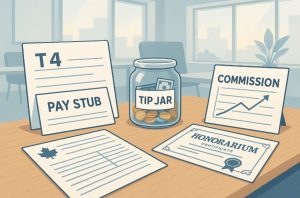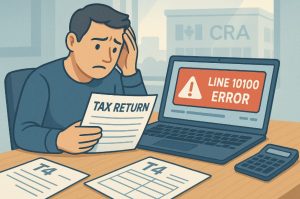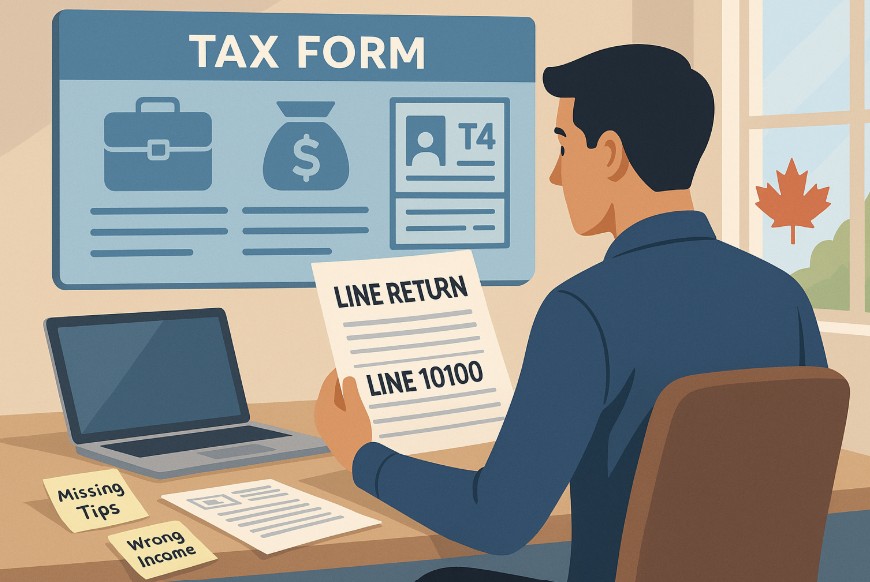Have you ever stared at your Canadian tax return, wondering what Line 10100 is really about? You’re not alone. Many Canadians are confused by the various lines on their tax forms, and understanding what each line means is key to filing accurately and avoiding issues with the Canada Revenue Agency (CRA). Line 10100, in particular, holds a significant place in determining your income and tax obligations.
This line captures your employment income, wages, salaries, commissions, and more, and forms the foundation of your tax calculation. If you misreport it, you could either pay more than necessary or risk penalties. The good news is that once you understand what goes into this line and how to report it properly, your tax filing becomes much clearer.
In this guide, you’ll learn everything you need to know about Line 10100, what it includes, how to report it, and how to avoid common mistakes.
What is Line 10100 on the Tax Return in Canada?

Line 10100 on your Canadian tax return refers to the total amount of employment income you earned during the tax year. It was previously known as Line 101 before the CRA updated its line numbering system. This is the line where you report income from employment only, including wages, salaries, bonuses, tips, and similar earnings.
You will find the relevant amounts on your T4 slips, especially in Box 14. If you worked multiple jobs, you need to include all your T4s and total the amounts for Line 10100. It’s also important to consider certain types of non-traditional employment income like honorariums or emergency volunteer pay, which can be included under specific conditions.
This line does not include self-employment income, investment income, or retirement pensions. It serves as the foundation of your taxable income and is crucial in calculating what you owe or what you get back as a refund from the CRA.
Why is Line 10100 Important for Your Canadian Tax Return?
Line 10100 is one of the most critical fields in your tax return because it directly influences your total income and the taxes you owe. Since it reflects your employment earnings, the CRA uses this number as the starting point for determining your federal and provincial taxes.
If you report this number incorrectly, you might:
- Owe additional taxes after reassessment
- Miss out on applicable credits and deductions
- Be subject to penalties or interest
Line 10100 also impacts your eligibility for benefits such as the Canada Workers Benefit and GST/HST credits. Because it is tied to your employment income only, it helps the CRA differentiate your job earnings from other income sources like self-employment, pensions, or investments. If you qualify, it also allows you to claim the Canada Employment Amount on Line 31260.
In short, it’s a foundational line that determines how much you’ll be taxed, what benefits you can receive, and whether your return is accurate.
What Types of Income Are Included in Line 10100?

When it comes to filling out Line 10100 on your tax return, knowing what kinds of income belong there is essential. This line strictly pertains to employment income, which means only certain earnings should be included.
Here’s a detailed breakdown:
T4 Slip Income
Most of the income reported on Line 10100 comes directly from your T4 slip, particularly from Box 14. This includes any salary or wages you earned from employers during the year. If you worked multiple jobs, each employer is required to give you a T4 slip, and you need to total the Box 14 amounts from all slips.
Wages, Salaries, Tips, Commissions, Bonuses
All of these are standard forms of employment compensation:
- Wages and salaries from full-time or part-time work
- Tips and gratuities earned in the service industry
- Commissions received, especially in sales roles
- Bonuses given for performance, holiday pay, or retention
Even if tips are not recorded on your T4, they still need to be reported honestly on Line 10100.
Honorariums and Other Employment Earnings
If you receive a one-time payment (an honorarium) for a service you performed, this could count as employment income depending on the source. Similarly, volunteer emergency responders like firefighters may need to report earnings above the exempt limit. These payments may appear on a T4A or be directly listed by your employer.
To summarize, only employment-related earnings go into Line 10100, and they must come from services performed during the calendar year.
How Do You Report Employment Income on Line 10100?
Filing your employment income on Line 10100 accurately ensures your tax return is correct. This line is not just about numbers, it’s about reflecting your actual income to the CRA. Here’s how to do it effectively:
Using Your T4 Slip to Fill Out This Line
Your T4 slip contains the most important details you need. Look for Box 14, which shows the total employment income paid to you by that employer. If you had multiple jobs, each employer should provide you with a T4, and you should add up all Box 14 amounts to report a single total on Line 10100.
Online vs Paper Tax Filing
You can file your tax return online using certified tax software such as NETFILE-compatible tools or through the CRA’s MyAccount. Most software pulls in your T4 slips automatically.
If you file by paper, you’ll manually add all your T4 amounts and write the total in Line 10100 on page 3 of your Income Tax and Benefit Return.
CRA Guidance on Reporting Correctly
The CRA recommends double-checking the figures, especially if you receive non-standard payments like lump sums, retroactive pay, or income adjustments. Ensure all income reported matches what’s on your T4s. If you’re unsure, contact your employer or refer to the CRA’s guide on employment income. Keeping records and reporting accurately will save you time and potential corrections later.
What Happens If You Report Line 10100 Incorrectly?

Errors on Line 10100 can lead to several consequences that might cost you money or delay your return. Because this line forms the basis of your total income calculation, any mistakes here impact everything downstream in your tax return.
You may receive a reassessment notice from the CRA if they detect mismatches between what you reported and what your employer submitted. This often happens when T4 slips are missed, misreported, or employment income is not included accurately.
Incorrect entries could also result in underpayment or overpayment of taxes. If you underreport, you might owe interest or penalties. Overreporting could delay refunds or increase your tax liability unnecessarily.
To avoid these issues:
- Verify all income against your T4 slips
- Check CRA’s MyAccount for digital T4s
- Review past tax records if you’re amending previous filings
Accurate reporting ensures peace of mind and avoids CRA intervention.
How is Line 10100 Different from Other Lines on the Tax Return?
Understanding the difference between Line 10100 and other lines on your tax return helps you categorize your income correctly. Line 10100 is specifically for employment income, but other lines also deal with income.
Line 10400 covers additional employment income not reported on a T4, such as foreign income or freelance jobs. Meanwhile, Line 15000 totals all sources of income employment, rental, investment, pensions, and more.
If your only income is from employment and is accurately reflected in T4 slips, then Line 10100 and Line 15000 may be the same. However, if you have investments or side income, Line 15000 will be higher.
The distinction is important when claiming deductions or understanding your net income on Line 23600. Each line serves a different purpose, so ensure the amounts are placed accordingly. Misplacing income between these lines could trigger audits or recalculations.
What Are Common Mistakes to Avoid with Line 10100?

Many Canadians make avoidable mistakes when entering data on Line 10100, which can delay their refund or create problems with the CRA. The most common issue is missing a T4 slip entirely, especially if you’ve changed jobs or worked multiple part-time roles.
Another frequent mistake is including non-employment income like self-employment earnings, pensions, or rental income, these belong on other lines, not Line 10100.
People often forget:
- To report tips not shown on a T4
- To add bonuses and lump-sum payments
- To correct errors if an employer issues a revised T4
Avoid these by:
- Double-checking CRA’s MyAccount for missing slips
- Keeping a detailed log of all your income sources
- Reviewing each employer-issued slip thoroughly
Taking time to ensure the accuracy of Line 10100 will make your tax filing process much smoother and more reliable.
When Should You Seek Help With Reporting Line 10100?
There are times when reporting Line 10100 becomes complicated, and professional help can make all the difference. If you worked multiple jobs, received unique types of employment income, or had complex employment agreements, consulting a tax expert is wise.
Other scenarios include:
- Receiving a lump-sum payment or retroactive pay
- Filing adjustments from previous years
- Being paid in cash or without a formal T4 slip
Tax software can assist with standard filings, but if your return includes bonuses, volunteer pay, or complicated employment deductions, a professional tax preparer ensures accuracy.
Additionally, if CRA has contacted you regarding past errors or if your income situation has drastically changed, it’s smart to get help before submitting. Even if you’re confident, having someone review your return can add peace of mind and help you maximize your deductions legally.
What to Include on Line 10100?
| Type of Income | Include on Line 10100? | Source Document |
| Wages and Salaries | Yes | T4 (Box 14) |
| Tips and Gratuities | Yes | T4 or estimation |
| Commissions and Bonuses | Yes | T4 |
| Honorariums | Yes | T4A or T4 |
| Self-Employment Income | No | T2125 |
| Employment Insurance | No | T4E |
| Volunteer Emergency Services Income | Yes (partial or full) | T4 (Box 14, Box 87) |
| Lump-sum Payments | Yes | T4 |
| Housing Allowance (Clergy) | Partially | T4 (Box 14, Box 30) |
Conclusion
Understanding Line 10100 is crucial for filing your Canadian tax return accurately. This line represents your employment income and acts as the foundation of your total income calculation. Knowing what to include, how to find it on your T4, and how to avoid mistakes ensures a smoother experience with the CRA.
Make sure all T4 slips are considered, especially if you’ve held multiple jobs or earned different types of income. Avoid misplacing other income sources into Line 10100 to prevent delays or corrections. If in doubt, tax professionals and CRA resources are available to guide you.
When filled out correctly, Line 10100 becomes a straightforward step in your tax process, helping you avoid audits, penalties, and unnecessary stress.
FAQs
What if I forgot to include one of my T4 slips?
You can amend your tax return using the CRA’s ReFile service or submit an adjustment request to correct the error.
Is Line 10100 the same as my total income?
Not always. Line 10100 includes only employment income, while Line 15000 includes all types of income, including investment or rental.
Can I use Line 10100 for foreign employment income?
No. Foreign income should be reported on Line 10400, not Line 10100, unless it appears on a Canadian T4.
Are honorariums always included on Line 10100?
If you received an honorarium for services from an employer, then yes, it should be included on Line 10100 or sometimes on Line 10400 if not on a T4.
How do I know if my tips should be reported?
Tips are part of employment income and should be included even if they are not recorded on a T4 slip.
Can I report my employment income without a T4?
Yes, but it’s best to contact your employer for an official slip. You can estimate and report it based on records if necessary.
What’s the difference between Line 10100 and Line 10400?
Line 10100 is for traditional employment income, while Line 10400 includes other income types like freelance or foreign employment.




